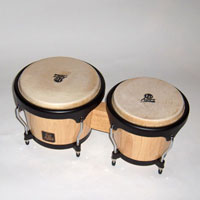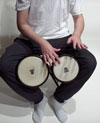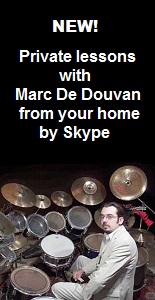
: : : Percussions : : Cuba : Instruments
The bongos or "bongoes"

The bongos are a small version of the congas, and come in their continuation (diameter from 6 to 9'', shell with oak staves glued and varnished, cow skin, steel hoops and screws (lugs, threaded rods (usually 4)). The principle of bongos, which associates each time a pair of drums, one small and one large, related by a wooden short bracket, is found in North Africa with pairs of "darbuka" (terracotta hand drum with fish skin strained by gut, with a shell with double cones imbricated and inverted shaped close to the "djembe", or an upside down vase and drilled from both sides), connected by dried gut.
Its basic rhythm is very close to the basic rhythm of the djembe: a beguine which high notes marking the beat ("cafe con pan").

You can install the bongos by wedging between the legs at the knees, sitting on a stool (horizontal seat), the small bongo to the left, or use a special stand that also allows you to play standing up.
Some drummers include a bongos stand with their congas, to enlarge their range of tones or sounds.
But the bongos are not played with the same technique as congas, to make them sound. First, it should be noted that the high pitched bongo must be extremely tight, to improve the sound level, weakened by its necessary smallness of sounding box (otherwise it would not make a high tone). Next, to make vibrate at most the skins, which are smaller and have less tendency to resonate, you have to play with the fingertips, or just the last phalanx of the middle finger or index, and hit the skin to the place more resonant: about a third from the rim. The fingers should "bounce" to let resonate, but those are the arms that lead the strokes (unlike the playing on darbuka, where only the wrist or finger joints are involved, a bit like for a piano).
Some bongos players extend the scope of striking techniques, using also the "slap", the muffled stroke (as with the congas or djembe), or "drumming" of the fingers (as in piano: quick alternation of striking the little, ring, middle, index fingers and even the thumb, which can be alternated between hands (example: middle and then index finger of the right hand, then the middle and index finger of the left hand (traditional roll used for the "Zarb", a kind of Persian wooden darbuka)).
In salsa music bongos player improvised generally almost continuously during a mambo, and plays a cowbell which he holds in his hand during a montuno (both types of polyrhythms often succeed following the alternating verse-chorus). This bell called "bongo bell" is large and low. The fact to hold it in hand, allows the bongo player to a pendulum move with bell and wrist, in complementarity of the movement of the stick to quickly pass from a stroke on the flat with the tip of the stick, "soft", to a stroke on the edge of the opening with the shaft, "loud" (the bell opening should be placed in front of the player and the flat above). The basic pattern consists to play all the beats with the edge and rumba clave with the flat (the clave montuno is usually "reversed" (2-3 clave)).
Finally, in contemporary music, some percussionists and drummers can use the bongos with sticks, to give a Latin look or creating a subtle and unusual sound (Example: Horacio "El Negro" Hernandez ).
audio demos:
- Tonic (open tone) stroke (high pitched)
- Tonic (low)
- Muffled stroke (high)
- Slap (high)
- "Cafe con pan" (biguine)
Marc De Douvan, November 2005, augmented and translated in English: May 2013.
© 2005 Marc de Douvan Crédits Mentions légales
